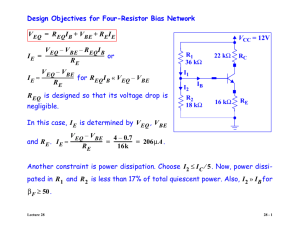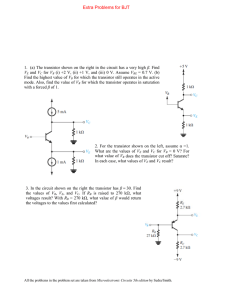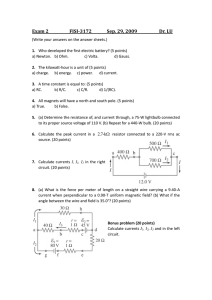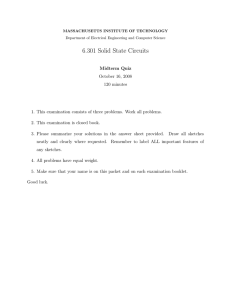Current Sources and Active Loads
advertisement
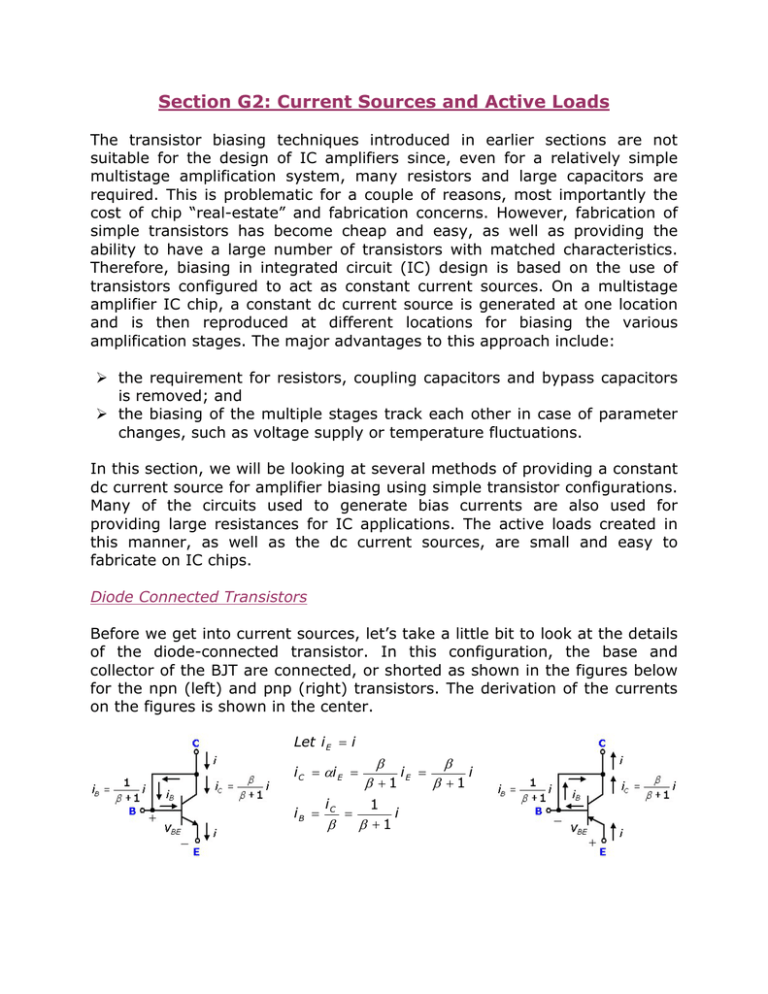
Section G2: Current Sources and Active Loads The transistor biasing techniques introduced in earlier sections are not suitable for the design of IC amplifiers since, even for a relatively simple multistage amplification system, many resistors and large capacitors are required. This is problematic for a couple of reasons, most importantly the cost of chip “real-estate” and fabrication concerns. However, fabrication of simple transistors has become cheap and easy, as well as providing the ability to have a large number of transistors with matched characteristics. Therefore, biasing in integrated circuit (IC) design is based on the use of transistors configured to act as constant current sources. On a multistage amplifier IC chip, a constant dc current source is generated at one location and is then reproduced at different locations for biasing the various amplification stages. The major advantages to this approach include: ¾ the requirement for resistors, coupling capacitors and bypass capacitors is removed; and ¾ the biasing of the multiple stages track each other in case of parameter changes, such as voltage supply or temperature fluctuations. In this section, we will be looking at several methods of providing a constant dc current source for amplifier biasing using simple transistor configurations. Many of the circuits used to generate bias currents are also used for providing large resistances for IC applications. The active loads created in this manner, as well as the dc current sources, are small and easy to fabricate on IC chips. Diode Connected Transistors Before we get into current sources, let’s take a little bit to look at the details of the diode-connected transistor. In this configuration, the base and collector of the BJT are connected, or shorted as shown in the figures below for the npn (left) and pnp (right) transistors. The derivation of the currents on the figures is shown in the center. Let i E = i i C = αi E = iB = iC β = β β +1 1 i β +1 iE = β β +1 i To illustrate the development of the simplified model for a diode-connected BJT, we’re going to use the npn device. As usual, development for the pnp is directly analogous with current directions reversed and polarities switched. Starting with the usual small signal model, where the base and collector are shorted, we have: Assuming rπ << ro, rπ||ro ≈ rπ and the circuit is simplified to a single resistor in parallel with the dependent current source: Now…reflecting rπ from the base circuit to the emitter circuit (recall that rπ=(β+1)re), we are left with a short in the base-emitter leg: The dependent source is shorted out and we end up with a single resistance between the base-collector terminal and the emitter terminal. So, long story short. A diode-connected transistor may be replaced by a single resistor…pretty cool, huh? A Simple Current Source (Current Mirror) The most basic building block in the design of IC current sources, also known as the current mirror, is shown in the figure to the right (a modified version of Figure 5.27 in your text). The transistors, Q1 and Q2, are matched devices with their bases and emitters tied together. The transistor designated Q1 in the figure is connected as a diode by shorting its base and collector terminals. A reference current, IREF, is the input to the current mirror at the collector of the diode-connected transistor Q1 and the output is taken from the collector of Q2. Note: Q2 must remain in the active (linear) region of operation by keeping its collector voltage higher than the base voltage at all times. It is important that the loading effect of any circuit fed by this current mirror should be inspected to ensure maintaining this mode of operation. The key point to the analysis of the current mirror circuit is that the transistors are matched and have the same VBE. Using this and examining the circuit above, the input current IREF flows through Q1 and sets up a voltage across Q1. This voltage then appears across the base and emitter of Q2 since the devices are connected in parallel. Assuming the assumption IC=IE is valid (β≈β+1), and using the fact that the transistors are matched, the emitter currents of Q1 and Q2 are the same and equal to IREF. As long as Q2 remains in the active region of operation, the output current, Iout, will also be approximately equal to IREF. If the effect of finite β is considered, the currents are as indicated in the figure above. This may lead to an output current that is not equal to the input reference current, since I out = β β +1 I E and I REF = β +2 IE , β +1 (Equations 5.59 & 5.60) where the expression for IREF is found by using KCL at the collector of Q1. The current gain of the current mirror is I out β = , I REF β +2 which approaches unity for β very large. Another deviation of Iout from IREF has to do with the Early effect. Since the VBE of Q2 is constant as determined by IREF, the output resistance of Q2 determines the dependence of Iout. This may be perceived as a disadvantage of this configuration – the output resistance of the current mirror (called RTH in your text) is limited by the ro of Q2, or ro = VA V ≈ A . I out I REF Widlar Current Source The Widlar current source differs from the basic current mirror in one important way – a resistor (R2) is added to the emitter circuit of transistor Q2. Since multistage amplifier systems often have high gain, bias currents must be small. Instead of the large resistors required to create small currents, the Widlar current source generates small constant currents using relatively small resistors. This allows considerable savings in chip real estate – which, as was mentioned before and will be mentioned often, is considered one of the ultimate goals in IC design. The dc representation of Equation 4.10 is (assuming n=1) IC = Ioe ⎛ VBE ⎜ ⎜ V ⎝ T ⎞ ⎟ ⎟ ⎠ , (Equation 4.10, Modified) where Io is the reverse saturation current VT is the thermal voltage (kT/q≈26mV at room temperature) Solving Equation 4.10 for VBE, we get ⎛I VBE = VT ln⎜⎜ C ⎝ IO ⎞ ⎟⎟ . ⎠ Using this information, and neglecting base currents, we can express VBE1 and VBE2 in the circuit above as follows: ⎛I ⎞ ⎛I VBE 1 = VT ln⎜⎜ C 1 ⎟⎟ ≅ VT ln⎜⎜ REF ⎝ IO ⎠ ⎝ IO ⎞ ⎟⎟; ⎠ ⎛I VBE 2 = VT ln⎜⎜ C 2 ⎝ IO ⎞ ⎛I ⎟⎟ = VT ln⎜⎜ out ⎠ ⎝ IO ⎞ ⎟⎟ . ⎠ Assuming we have matched devices, VT and IO are the same for Q1 and Q2. Subtracting VBE2 from VBE1, and using the appropriate property of logarithms (i.e., lnA-lnB=ln(A/B)), we get ⎛I VBE 1 − VBE 2 = VT ln⎜⎜ REF ⎝ I out ⎞ ⎟⎟ . ⎠ Hang on, we’re getting ready to use all this stuff! Writing a KVL around the base loop of the two transistors, VBE1 = VBE 2 + I E 2 R2 ; or VBE1 − VBE 2 = I E 2 R2 . (Equation 5.61) Here we go! Assuming that IC2=IE2=Iout, and using our expression for VBE1VBE2, ⎛I I out R2 = VT ln⎜⎜ REF ⎝ I out ⎞ ⎟⎟ . ⎠ (Equation 5.63, Modified) Since IREF (=IC1) is usually defined in design, Equation 5.63 can be solved for the required value of R2. Another improvement of the Widlar current source over the basic current mirror is the increased output resistance. The figure to the left below (Figure 5.29a) is the ac small signal model of the Widlar current source, and that to the right is a simplified version (Figure 5.29b), where r’π=(R1||re)+rπ. Now, before you convince yourself that this cannot be right, remember that the small signal model of a diode connected BJT is simply re… Using the method of applying a test voltage vTH and solving for the resulting current iTH (or vice versa), we can solve for RTH=vTH/iTH. Analyzing the simplified circuit (above right), we get the following definitions: v TH = v 1 + v 2 v 1 = − i b2 r ' π v 2 = (iTH − βi b2 )ro . i TH = β i b2 + (Equations 5.64 & 5.65) v2 ro The equivalent output resistance is then given by: RTH = ro (1 + β + rπ' / R2 ) + rπ' 1 + rπ' / R2 . (Equation 5.66) By making the assumption that r’π is much larger than R2, and using r’π=βVT/IC2, the equivalent output resistance may be approximated by ⎛ I R RTH = ro ⎜⎜1 + C 2 2 VT ⎝ ⎛ ⎞ I R ⎟⎟ = ro ⎜⎜1 + out 2 VT ⎝ ⎠ ⎞ ⎟⎟ . ⎠ (Equation 5.69) Note that the term IoutR2 is the dc voltage drop across the resistor R2 and the larger this voltage, the larger the output resistance. Wilson Current Source Another current source configuration that possesses increased output resistance is the Wilson current source. The increased ro of the Wilson current source is due to the negative feedback provided by Q3. This configuration uses three transistors as shown in Figure 5.30 of your text and as reproduced to the right. Performing an analysis similar to the Widlar current source, we can derive an expression for the output resistance of the Wilson current source to be: RTH = βro 2 = βV A 2I C 2 Writing a KCL equation at the emitter of Q2: . (Equation 5.80) I E 2 = I C 3 + I B1 + I B3 . (Equation 5.71) If all three transistors are matched VBE1=VBE2=VBE3, β1=β2=β3, IB1=IB3, and IC1=IC3. With this information and the relationship between base and collector currents (IB=IC/β), we can rewrite the expression for IE2 as ⎛ 2⎞ I E 2 = I C 3 ⎜⎜1 + ⎟⎟ . β⎠ ⎝ (Equation 5.73) Using IC2=αIE2=βIE2/(β+1) and simplifying, IC2 = I C 3 (1 + 2 / β )β I (β + 2) = C3 . β +1 (β + 1) (Equation 5.75, Modified) Now, if we sum the currents at the base of Q2, I C 1 = I C 3 = I REF − I B2 = I REF − I C 2 / β . (Equation 5.76, Modified) Substituting Equation 5.76 into Equation 5.75 and solving for IC2, we get an expression for the output current (IC2) in terms of the transistor parameter β and the input current, IREF: IC2 ⎛ ⎞ β 2 + 2β 2 ⎟⎟ I REF . I REF = ⎜⎜1 − 2 = 2 β + 2β + 2 β β + + 2 2 ⎝ ⎠ (Equation 5.78) For reasonable values of β, the second term will be negligible and IC2=Iout=IREF. Therefore, in addition to the increased output resistance, the Wilson configuration provides an output that is almost independent of the internal transistor characteristics…a very good thing! Multiple Current Sources Using Current Mirrors As mentioned earlier, a constant dc current may be generated at some point on a chip and reproduced at multiple other locations to bias the various amplifier stages on the IC. An example of such a circuit is shown to the right and is a modified version of Figure 5.31 in your text. Note that Q2 and Q3 form a current mirror with transistor Q1, while Q4 is a Widlar current source because it has a resistor in the emitter leg. The amount of current delivered by this source can be determined by the size of this emitter resistor. Also, when using the Widlar circuit, the output current(s) may be different from the original reference current, IIN. However, there is a point of concern when using a multiple current source circuit. The effect of finite transistor β yields a cumulative effect of errors introduced by multiple base currents. This problem is easily overcome by restricting the number of outputs of the multiple current source and carefully selecting transistors with appropriate β.

